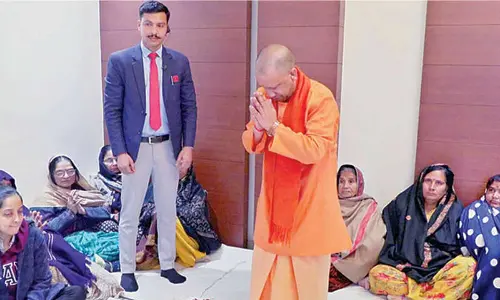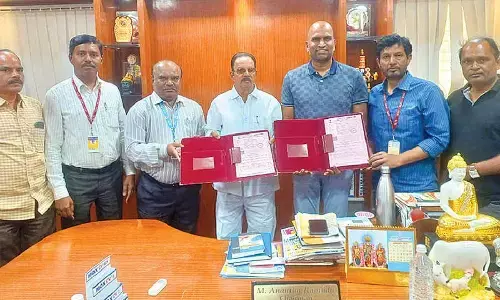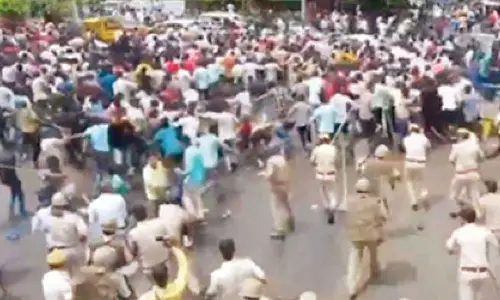Romas look up to Ambedkar

Although centuries and hundreds of kilometre apart, the Romas are viewed as part of the evolution among the people who are Dalits back home, striving to rise socially and economically, to assert their political presence. The Gandhi High School in Pecs, another Hungarian city, also caters to education of the Romas who are really Europe’s unwanted people.
Sajokaza, a town situated on Hungary’s border with Slovakia and University of West Hungary, Sopron, located on border with Austria in the heart of Central Europe are unlikely places for study and research of Dr Babasaheb Ambedkar. But they are not.
With their libraries having books and videos on the Indian leader, they are important European outposts propagating Ambedkar’s ideas far away from his home. On April 14, an Ambedkar bust, said to be first in Europe, was installed at the Ambedkar Institute in Sajokaza, where a half of the 3,300 population are Romas. It is gifted by the Indian Council for Cultural Relations (ICCR), the cultural arm of the External Affairs Ministry that runs a centre aptly named after Amrita Shergill, the Indian-Hungarian painter of repute.
A similar function was held at Sopron on April 19 commemorating the 125th birth anniversary of Dr Ambedkar. Welcomed by Dr Attila Fabian, Dean of the University, Indian Ambassador Rahul Chhabra gave a presentation on his country’s diversities and on the life and ideals of the man who wrote India’s Constitution.
Indian film-maker Jabbar Patel’s award-winning film on Ambedkar was screened. A cultural show featuring tabla recital Pandit Rajesh Gangwani, a Kathak performance by Soumya Shukla and Kuchipudi by Hungarian artiste Gabriella Toth were the highlights of the two functions.
A few things, not very well known, need highlighting. One is the intense love for things Indian in Hungary and other Central European countries. The other is the focus on Ambedkar that has been nurtured over the last few years by Ambedkar’s followers in Maharashtra. In Hungary, his ideals are interpreted in the context of human rights.
Buddhists in Hungary trace the name of the national capital Budapest to Buddha. And Jai Bhim organisation runs a branch in Hungary under Mr Janos Orsoz, leader of Jay Bhim Triratna, Buddhist Community. The Indian Ambedkarites identify themselves with Romas, or the gypsies, the nomads who are supposed to have migrated from India centuries ago. A half of Sajokaza’s 3,300 people are Romas.
Although centuries and hundreds of kilometre apart, the Romas are viewed as part of the evolution among the people who are Dalits back home, striving to rise socially and economically, to assert their political presence. The Gandhi High School in Pecs, another Hungarian city, also caters to education of the Romas who are really Europe’s unwanted people.
They constitute one of the biggest minority blocks in Europe and have a history of being constantly discriminated against, persecuted and stigmatised by White Europeans.After discovering Ambedkar through latter’s books, Derdak Tibor and János Orsoz visited Maharashtra in 2005 and 2007.
In Hungary, Dr Babasaheb Ambedkar’s ideals are interpreted in the context of human rights. Buddhists in Hungary trace the name of the national capital Budapest to Buddha. And Jai Bhim organisation runs a branch in Hungary under Mr Janos Orsoz, leader of Jay Bhim Triratna, Buddhist Community.
The Indian Ambedkarites identify themselves with Romas, or the gypsies, the nomads who are supposed to have migrated from India centuries ago. A half of Sajokaza’s 3,300 people are Romas. Although centuries and hundreds of kilometre apart, the Romas are viewed as part of the evolution among the people who are Dalits back home, striving to rise socially and economically, to assert their political presence.
They felt a deep connection with the Dalits of India and with Ambedkar's emancipatory agenda. On returning to Hungary, in 2007, they founded the Jai Bhim Network, embraced Buddhism and opened three high schools named after Dr Ambedkar in Sajókaza, Ózd and Hegymeg for Roma children.
One of the activities of the network is to invite young Dalit activists from India to Hungary and provide them with opportunities to interact with the Roma community. One such delegation lived with the Roma community in Sajókaza for a month. Hungary is home to an estimated 500,000 Romas.
Its government supports the Indian Embassy’s and local effort as part of its programme to uplift the underprivileged among its ten million people. Participation by city mayors, cultural entries and the academia makes the effort worthwhile.
India has sought to reach out to the Romas, holding their congregations. The deepening interest is best underscored by the fact that Ambassador Malay Mishra, the previous envoy to Hungary, has on retirement last year begun to conduct his Ph.D. studies on Romas and their India connect.
Mishra, registered in the Institute for International Studies at Budapest’s Corvinus University, is studying to make a comparative study into the empowerment of marginalised groups in India, Hungary, Romania and the UK, with particular reference to Roma communities.
“Ambedkar was a contemporary of Gandhi and he fought for the rights of deprived classes,” says Mishra. “He was an advocate of affirmative action for the Dalits, or untouchables, and they were given quotas in schools, colleges, universities and public service jobs.
“This raised their economic standards. One of India’s presidents of the republic and a chief justice of the Supreme Court were Dalits. I am looking into whether it is possible that experimentation we have done in India to uplift communities can be extended here,” Mishra says.
There are actually 1,200 non-governmental organisations in Hungary working for the Roma. They have generous European Union funding plus Hungarian government support but there are not many beneficiaries. The funds are not always meeting the target groups.
There are many reasons for this, he says, and this forms part of his research. He is looking at two EU frameworks, the 2005-2015 Decade of Roma Inclusion and the 2011-2020 National Roma Integration Strategies. These define four pillars, to boost education, employment, health and housing.
“There is very uneven development in Hungary. Some Roma are well-off with good work and income, houses and school, but some parts are destitute and very marginalised with no agencies to help them,” Mishra says.The former envoy says poverty is a universal phenomenon and he is looking for a new direction. “I enjoy doing it and I believe there is a ray of hope,” he has been quoted as saying in Budapest Times.
“My work is going to be positive for policy makers in Europe and India,” stressed Ambassador Mishra.
Amrita Shergill Centre is located on the picturesque hilly side of Buda city with no direct local transport available.
Yet, the place attracts young among the local keen on learning Hindi or Tamil languages or the Indian classical music and dance. On May 2, the International Dance Day, an annual event organised by the centre, saw seven Indian dance styles introduced to the audiences.
Ms Virág Túri, leader of the Parvati Odissi Group, led the Indian classical dance performance with her Odissi dance. After the soft movements of Odissi dance, Ms Dóra Meenakshi Bittner performed a slow Bharatanatyam piece titled “Govardhana Giridhara”, telling a story of Lord Krishna.
The big draw at the Centre is a Bollywood film and this is true of the Indian missions and their cultural arms across Central Europe that was once part of the Soviet Bloc. The generation that admired Raj Kapoor is fading, but Mithun Chakraborty, other Kapoors and the Khans are currently popular.
Significantly, this region does not view India through colonial or post-colonial prism. The post-Soviet era has brought Western goodies and disposable incomes. But they remain rooted to their distinct cultures with high place for art, literature, dance and music. Art exhibitions or dance/ ballet/ opera events are advertised through hoardings on the streets and highly-priced ticket get sold out weeks in advance.
Anybody who had or has visited India, be it as teacher, tourist, language interpreter or student, has retained the India connect. It has been nurtured by its own momentum, what with spiritual gurus making their way after half-a-century of Marxist rule ended.
Yoga is gaining popularity. The International Yoga Day last year saw over 3,000 participants, one of the highest numbers worldwide, in Ljubljana, capital of Slovenia that was part of the erstwhile Yugoslavia. “We could do more,” Ambassador Sarvajeet Chakravarty pointed out with approving nods from a Slovenian lawmaker, a Roma journalist, Indian and Slovenian officials of various development and relief agencies.
The important thing is that India does not need to be introduced in this part of Europe. But it needs to be cultivated and promoted.















